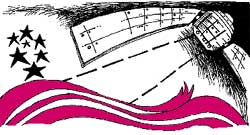Spy which loves nature
 with the end of the cold war, the formidable us military apparatus is being deployed for more peaceful purposes. us spy satellites are homing in on natural phenomena such as clouds, glaciers, deserts and tropical rainforests to yield a virtual treasure trove of information about global climatic change and ecological threats. "In terms of turning swords into plowshares, this is about as good an example as I can think of,' says Jeff Dozier, dean of the school of environmental science at the University of California and a member of the programme's management team.
with the end of the cold war, the formidable us military apparatus is being deployed for more peaceful purposes. us spy satellites are homing in on natural phenomena such as clouds, glaciers, deserts and tropical rainforests to yield a virtual treasure trove of information about global climatic change and ecological threats. "In terms of turning swords into plowshares, this is about as good an example as I can think of,' says Jeff Dozier, dean of the school of environmental science at the University of California and a member of the programme's management team.
At the behest of us Vice President Al Gore and with the support of Congress, spy satellites will zero in on about 24 ecologically sensitive sites around the world under the new programme. Ultimately, they will monitor around 500 cities. The data gathered by the satellites will not be immediately available because the aim is to keep the nation's reconnaissance systems under wraps for now, but will be archived for future generations of scientists. The data will be relevant in future decades because it seeks to reveal trends over a passage of time.
The satellites will focus on those areas of the earth, which reveal changes in the natural world and repeatedly photograph them according to a fixed schedule, seasonally in some cases. So as to not miss out on the minutae of ecological shifts, data will be collected for decades. A prime example is Mt Kiliminjaro near the Kenya border which is to be studied for signs of changes in its high forests due to the earth's rising levels of carbon dioxide.
Spearheading the efforts to build up invaluable environmental data through the deployment of satellites is the Measurements of Earth Data for Environmental Analysis (medea), a group of about 60 scientists in academia and industry. Their mandate is to render advice to the nation's intelligence agencies on the use of secret data to study the environment. Explaining the rationale behind the programme, Gordon J MacDonald, medea's chairperson and a geophysicist at the University of California in San Diego, asserts: "We want to make sure that the scientist working in 2020 has with him a lot of relevant information.' medea is assisted by the National Reconnaissance Office in the Pentagon and the reconnaissance effort is coordinated by the Central Intelligence Agency.
As against the photographs which were originally taken for military reasons and were often hit and miss efforts in terms of ecological relevance, the medea effort directly targets nature with all its subtleties.
Similarly, spy satellites are a notch above run-of-the mill environmental studies in various ways: coverage is wider and cheaper than that done by groups of scientists on the ground and can help in identifying trends. Spy satellites can yield valuable data about farflung areas which are almost inaccessible by other means. Spy satellites are better than civilian remote-sensing crafts such as the us Landsat and France's Spot because they can zoom in on ground targets, giving scientists a wealth of information. "You can use the intelligence assets to make the interpretation of the civilian ones much more accurate,' says Dozier.
To guage how effectively these spy satellites can monitor natural sites, the medea group is conducting around 24 experiments. While the experimental areas are long term ecological reserves around the us, in the near future the programme will expand to cover hundreds of domestic and foreign sites. Of the 260 immediate site areas that have been selected are clouds off the California coast, the Luquillo Experimental forest in Puerto Rico, the coastal zone around the Galapagos Islands, off Ecuador, permafrost in Fish Creek, Alaska and a mixed coniferous-deciduous forest in Pleshscheyevo, Russia.
Furthermore, as Rahul Roy Choudhury, a research officer at the New Delhi-based Institute of Defence Studies and Analysis points out: "The question before the us at the end of the cold war in 1989-90 and at the disintegration of the Soviet Union in 1991 was how to guarantee continued funding for research and development of sophisticated technology in terms of satellite or verification technology.' The biggest plus point for medea was the support of the Republican-led congress which turned a deaf ear to the carping of critics who maintained that such programmes were inappropriate and wasteful and therefore should be eliminated.
Some reservations about the new environmental reconnaisance efforts have, however, been expressed. "I am worried that it will be vulnerable to the ebbs and flows of security politics. Like Star Wars and the b-1 bomber, these things come and go,' maintains Marc A Levy, a political scientist at Princeton University who studies ecological politics.
Such doubts do not plague the scientists involved in the effort to deploy satellites on the new ecological mission. They point out that the overheads of the programme are so low and the possible gains so large that it is likely to be around in the foreseeable future.
